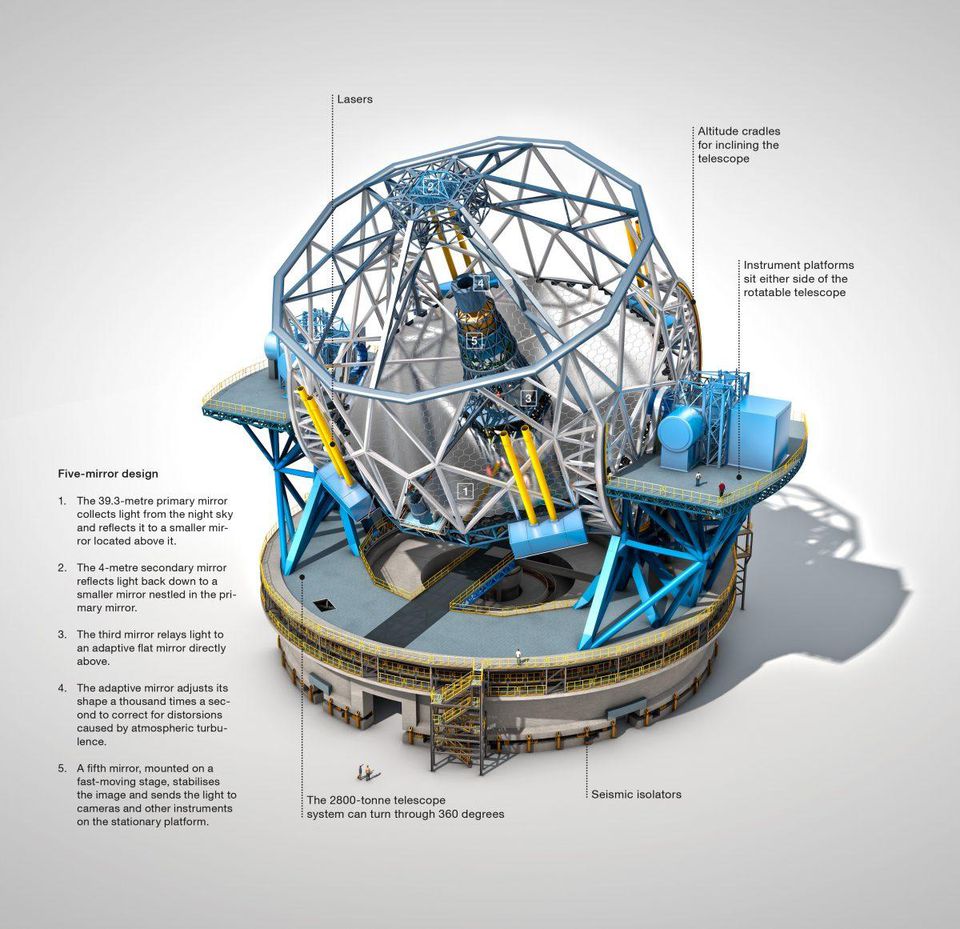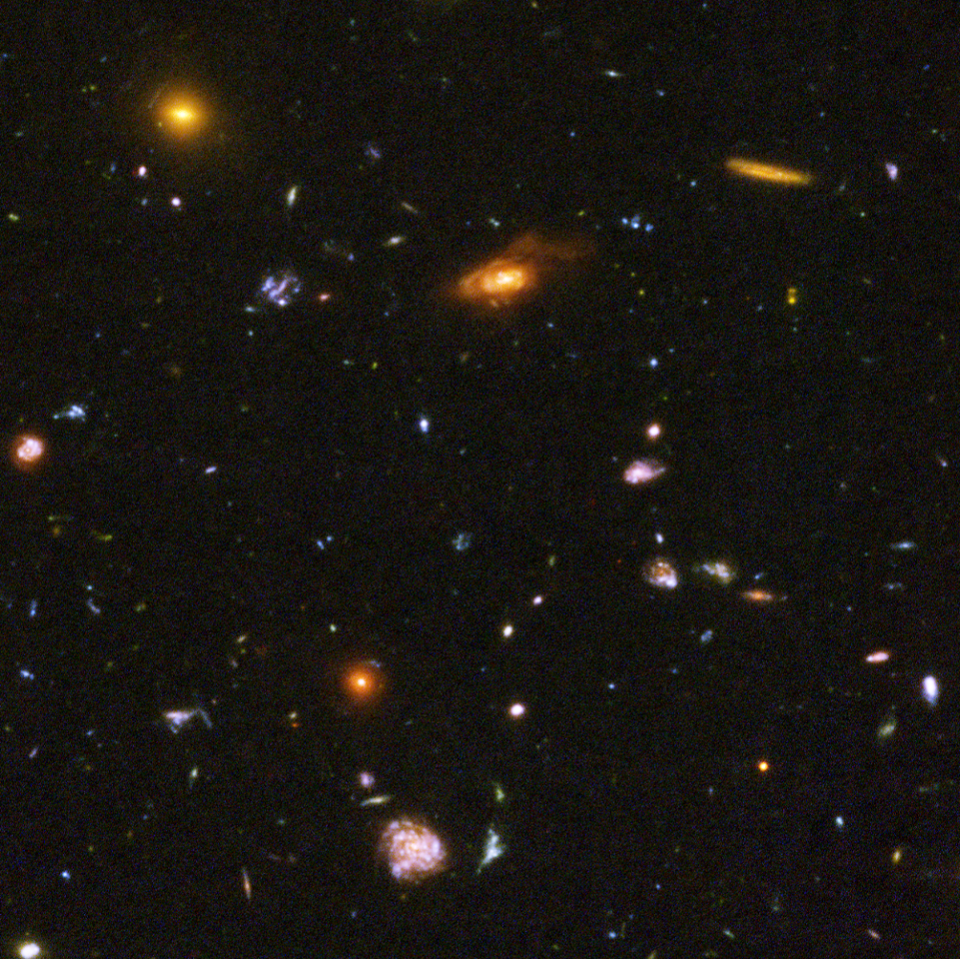The world's largest telescope will finally be able to see stars without diffraction rays.
- Transfer

Huge, 25-meter giant Magellan telescope (HMT) will not only open a new era of terrestrial astronomy, but also receive the first, most modern images of the Universe, on which stars will look exactly as they are, without diffraction rays
When looking at the greatest images of the universe, we turn on memory and imagination. We can look at the planets of the Solar System with amazing detail, galaxies located millions or even billions of light-years away, nebulae where new stars are born, and stellar remains that have the eerie, fatalistic appearance of our cosmic past and future of our solar system. But the most common objects in these photographs are the stars, available everywhere and in all directions, wherever we look, both in our Milky Way and beyond. And on all images, from ground-based telescopes to Hubble, the rays of the stars are almost always visible: this is an artifact of the image inherent in the telescope design. We are preparing for the next generation of telescopes, and among them stands the 25-meterThe giant Magellan telescope (HMT): it alone will not have these diffraction rays .

The Hickson Compact Group 31 , shot by Hubble, is a beautiful “constellation” of galaxies, but several stars from our own Galaxy, which are distinguished by diffraction rays, come to the fore. These rays will not be only when using HMT.
Telescope can be made in different ways; in principle, it is only necessary to collect and focus the light of the Universe on the same plane. Early telescopes were built according to the type of refractorswhen incoming light passes through a large lens and focuses on a single point from which it can be redirected to the eye, to a photographic plate or (which is more modern) to a digital matrix. But the capabilities of refractors are fundamentally limited by the physical size of the lens of the desired quality. Such telescopes do not exceed a meter in diameter. Since the image quality is determined by the diameter of the aperture, both in resolution and in luminosity, refractors went out of fashion more than 100 years ago.

Reflector telescopes have long replaced refractors, and the size available for creating a mirror seriously exceeds the one that is available for a lens of similar quality.
But another scheme is a reflector telescope.- can be much more powerful. A mirror with a well-reflecting surface of suitable shape can focus incoming light on a single point, and the size of the mirror that can be cast and polished greatly exceeds the size of the maximum lens. The largest single-mirror telescopes reflectors can reach as much as 8 meters in diameter, and the segmentation of mirrors can reach even larger sizes. Currently, the Big Canary telescope with a diameter of 10.4 m is the largest in the world , but in the next decade this record will be beaten by two (and possibly three) telescopes: a 25-meter high-altitude engine and a 39-meter European extremely large telescope , ELT.

The comparative size of the mirrors of various existing and projected telescopes. When GMT is launched, it will become the largest in the world, the first optical telescope with a diameter of 25 m in history, but then it will eclipse the ELT. But all of these telescopes have mirrors, and all of them are reflectors.
Both of these telescopes are multi-segment reflectors, and should give us images of the Universe unprecedented before. ELT will be larger in diameter and number of segments, as well as in cost, and it will have to be completed several years after GMT. HMT will be smaller in diameter and number of segments (although the segments themselves will be larger), cheaper, and will be completed faster. The stages of its construction are as follows:
- digging of the pit began in February 2018,
- Concrete Bay - 2019,
- construction of a building fully weatherproof - 2021,
- telescope delivery - 2022,
- installation of primary mirrors - beginning of 2023,
- the first light is the end of 2023,
- first scientific research - 2024,
- the planned completion of construction is 2025.
Pretty soon! But even with such an ambitious schedule, GMT will have a huge optical advantage, and not only over ELT, but in general over all reflectors: the stars it has shot will not have diffraction rays.

It is believed that the star, dispelling the Bubble Nebula , can be 40 times more massive than the Sun. Notice how diffraction rays interfere with the observation of less bright structures nearby.
The familiar rays you observe in images from observatories such as the Hubble telescope appear not because of the main mirror, but because of the need for successive reflections that focus the light on its final goal. To do this, it is necessary in some way to place and fix the secondary mirror, re-focusing the flow of light. There is no way to avoid the presence of supporting structures that hold the secondary mirror, and they find themselves in the path of light. The number and location of the supports determine the number of rays - four from Hubble, six from James Webb - and they can be seen in all the photos.

Comparison of diffraction rays for different locations of racks in the reflector. The inner circle is the secondary mirror, the outer one is the main one; Below are the final ray configurations.
All ground-based reflectors have such diffraction rays; they will be at the ELT. The gaps between the 798th hexagonal mirrors, despite the fact that their area will be no more than 1% of the total area of the mirror, will increase the strength of the rays. Every time we photograph a dim object that is unsuccessfully located close to something bright — to a star, for example — we get out of these diffraction rays. Even with the use of sliding photography, in which two almost identical photos are taken with a slight shift, and one is subtracted from the other, it will not be possible to completely get rid of these rays. An ELT with a primary mirror with a diameter of 39 m will be the world's largest eye staring into the sky when it starts working at the beginning of the next decade. This is a detailed preliminary scheme with the anatomy of the entire observatory [clickable]

But the GMT, which has seven huge eight-meter mirrors with one central and six mirrors symmetrically located around it, is ingeniously designed to eliminate these diffraction rays. Six exterior mirrors are arranged in such a way that narrow slits stretch from the edge of the light-collecting area to the central mirror. The secondary mirror is supported by thin "spider legs" racks, but each of them is located exactly above these slots. Since the racks do not block the light used by the exterior mirrors, there will be no rays in the image.

The 25-meter GMT is under construction now, and will become the greatest ground observatory of the Earth. The racks holding the secondary mirror are designed to fit exactly between the mirrors.
But instead, in this unique scheme - in which there will be cracks between the mirrors and the racks will cross the central mirror - a new set of artifacts will be observed: a set of circles appearing around the ring objects ( Airy disks ) that will surround each star. These circles will appear as empty spaces in the image, and will appear everywhere due to the telescope's layout. However, they will be of very low intensity, and will appear for a short time; these circles will fill the image when the sky and the telescope rotate during the night, accumulating light during a long exposure. After 15 minutes, the minimum, in fact, time to get a decent photo, these circles will completely disappear.

The nucleus of the Omega Centaurius globular cluster- one of the most densely populated areas containing old stars. GMT will be able to distinguish more stars than ever before, and without any diffraction rays.
As a result, we get the first world-class telescope that can see stars as they are - without diffraction rays! In its scheme there will be small compromises, the largest of which will consist in a small loss of luminosity. The physical diameter of the HMT will be 25.4 m, however, the light-gathering area will have a diameter of “only” of 22.5 m. However, a small loss of resolution and aperture power more than compensate for the capabilities of this telescope that distinguish it from all others.

Some of the most distant galaxies in the observable universe, seen through the Hubble Ultra Deep Field project. GMT will be able to photograph all these galaxies with a resolution ten times better than that of Hubble.
Its resolution will be from 6 to 10 angular milliseconds, depending on the wavelength - this is 10 times better than Hubble and 100 times more sensitive than it. He will be able to view distant galaxies at distances of ten billion light-years, and we will be able to establish their rotation curves, look for signs of fusion, measure the matter emanating from them, study the areas of star formation and signs of ionization. We can directly see terrestrial exoplanets, including Proxima Centauri blocated up to 30 light-years from us. Jupiter-type planets will be visible at distances of up to 300 light years. We also measure the parameters of the intergalactic medium and the percentage of chemical elements wherever we look. We can also detect the earliest supermassive black holes.

The farther away from us is the quasar or supermassive black hole, the more powerful the telescope (and the camera) are needed to detect it. The advantage of HMT will be the ability to carry out the spectroscopy of such ultra-distant objects after their detection.
We can also conduct direct spectroscopic measurements of individual stars in densely populated clusters and environments, study the details of the structure of nearby galaxies, and observe in detail the systems of two, three, and several stars. This includes even the stars in the center of the galaxy, located 25,000 light years away. And all this, of course, without diffraction rays.

The image demonstrates an improvement in the resolution of the image of the Galactic center with an angular size of 5 arc-seconds — from Keck's telescopes with adaptive optics to future telescopes such as HMT. And only on GMT stars will not have diffraction rays.
Compared to what we can see today in the best observatories of the world, the next generation of ground-based telescopes will open up a whole galaxy of new frontiers, tearing off the cover of mysteriousness from the unseen Universe. In addition to planets, stars, gas, plasma, black holes, galaxies and nebulae, we will look at objects and phenomena unseen before. And until we look at them, we will not know exactly what miracles the universe has prepared for us. Thanks to the ingenious and innovative project of HMT, the objects that we missed due to the diffraction rays of bright nearby stars will suddenly open to us. We have to observe a whole new Universe, and this unique telescope will reveal to us what so far no one can see.
